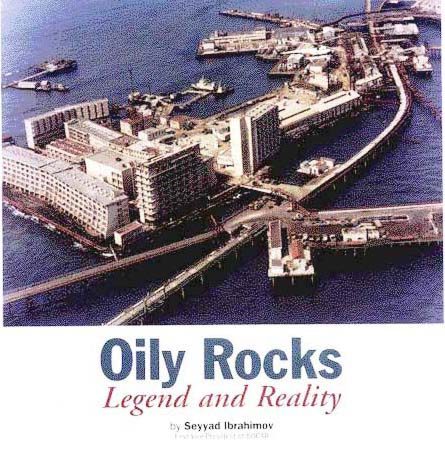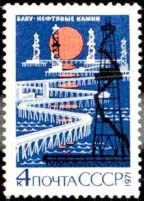|
 THE EARLY DAYS And just as predicted, it happened. Oil was struck at a depth of 1,100 meters beneath the Caspian. And when that black, thick fountain started to pour forth, no one could contain their excitement and exuberance. Everyone rushed to feel it, to put their hands in it and smear it all over their arms and faces, hugging each other and shouting for joy. Their hard work had finally proved successful.
A new name was coined that night: no longer would the place be known as "Black Rocks." The source of the "black" that passing ships had noted even a hundred years earlier, had finally been confirmed. Henceforth, it would be called "Oily Rocks" (Neft Dashlari). Members of that first expeditionary team often used to recall that night that took place nearly 50 years ago. The group was led by Aghagurban Aliyev, a geologist and Yusif Safarov, Deputy Head of the Exploration Drilling Trust, who was responsible for determining exactly where they should drill. Mikhail Kavyorochkin headed up the Exploration Drilling Trust. My own professional career in the oil industry began a few years later and was directly influenced by these pioneers who had been the first to challenge nature beneath the surface of the sea. The following morning after oil was struck, the Soviet Minister of Oil, Nikolai Babakov, himself, headed to Baku. A former Baku oilman, he held the first technical meeting right there next to the first well. Soon a base for the development of Oily Rocks was set up. A managing office "Glavmorneft" was established in Moscow headed by Sabit Orujov, a Deputy Minister, and another Azerbaijani who was especially talented as an organizer. A state research-production institute "Gipromorneftegaz" began scientific supervision of the project. THE 1960s My first assignment was a routine, technical job dealing with equipment but I enjoyed the work so much that after defending my diploma, I asked to continue my assignment there and soon worked my way into management. GENERATING ELECTRICITY For eleven years (1980-1991), I headed the Oil and Gas Production Institute there. Despite the difficult work dealing with unpredictable gushers and problems when trestles could not withstand the severe squalls off the Caspian, the oilmen worked with enthusiasm to overcome difficulties. In 1986, a gas turbine station was built to operate off gas extracted from the wells. This station now supplies Oily Rocks as well as the deep-water platforms on the Gunashli field. We had quite a struggle to get this station set up as Moscow insisted on transmitting energy through electric lines from the shore. But in the end, we succeeded in building an autonomous station which has been working successfully for the past 11 years. There has not been any interruption of electricity out there on Oily Rocks, which is more than can be said for onshore fields on the Absheron Peninsula. NO MORE TANKERS I'll never forget flying out to Oily Rocks once in a helicopter with him and Qurban Abbasov. Orujov told Abbasov, "You need to lay pipelines as soon as possible and get rid of the tankers." Reliance on ships had always been one of the weakest production points about Oily Rocks. During storms which can occur frequently on the sea and which can build up to the intensity of hurricanes, tankers had to stop work and so production accumulated. There was always danger that this would cause some of the wells to stop functioning. "But we don't have any pipes," Abbasov complained. Orujov immediately placed the order allocating pipes for the project. The pipeline was laid between Oily Rocks and Dubandi between 1979-83. So, thanks to Orujov, we got rid of tankers. In no place else is the need to care for oil workers greater than at Oily Rocks. About 3,000 men and women live and work there on one-to two-week shifts. Families don't live out there, nor are children allowed, but great care must be given to maintain the health of these workers, both physically and mentally. I was involved with organizing much of the construction there. One of the dormitories is nine stories tall; four others are five stories. Water is shipped in for consumption. Food has to be brought in although a bakery operates on the premises so flour, not bread, is shipped or flown in. RISING OF THE CASPIAN
SEA Because of my experience at Oily Rocks, I later became one of the pioneers of Gunashli and when "28 May Field" was established in 1994, I was assigned to head it. In 1995, I became the Head Engineer of the Production Union, "Kaspmorneftegaz." In 1995, I was appointed first vice-president of SOCAR. Today, much of my time and energy
is spent on issues related to the joint development of the Caspian
fields with international oil companies. But Oily Rocks is never
far from my mind. Oily Rocks is both legend and reality for me-a
combination of passion and romanticism, heroism and routine which
all blend together in my heart like a sweet melody. Back to Index
AI 5.2 (Summer 1997) |

